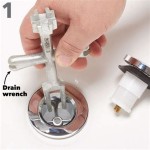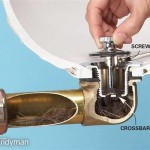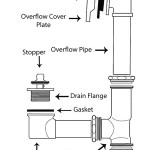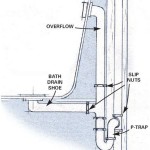Patching A Bathtub Hole: A Comprehensive Guide
Bathtubs, constructed from materials such as porcelain-enameled steel, acrylic, or fiberglass, are susceptible to damage over time. Impacts, dropped objects, and general wear and tear can result in chips, cracks, and even holes. While minor blemishes might be aesthetically displeasing, larger holes present a more significant problem, potentially leading to water damage within the bathroom and surrounding structures. Repairing a bathtub hole effectively requires understanding the nature of the damage, selecting appropriate materials, and following a meticulous patching process.
The severity of the hole dictates the necessary repair approach. Small chips and hairline cracks can often be addressed with specialized repair kits designed for cosmetic improvements. These kits typically include a color-matched epoxy or acrylic filler that is applied to the damaged area, sanded smooth, and polished to blend seamlessly with the surrounding surface. Larger holes, however, necessitate a more involved repair, requiring structural reinforcement to prevent future cracking and ensure a durable, watertight seal. Such repairs may involve the use of fiberglass cloth, epoxy resin, and specialized patching compounds.
Before undertaking any repair, it is crucial to accurately assess the extent of the damage and the material composition of the bathtub. Identifying the bathtub material is essential for selecting compatible patching materials. For example, a repair kit formulated for acrylic will not adhere properly to a porcelain-enameled steel tub. Similarly, the size and depth of the hole will determine the amount of filler and reinforcement required. Failure to properly assess these factors can result in a compromised repair that is prone to failure.
Key Point 1: Preparing the Damaged Area
Proper preparation is paramount for a successful bathtub hole repair. The area surrounding the hole must be thoroughly cleaned and prepared to ensure optimal adhesion of the patching materials. This process typically involves the following steps:
Cleaning: The damaged area and the surrounding surface should be cleaned with a mild detergent and water to remove any dirt, grease, soap scum, or other contaminants. Stubborn stains can be addressed with a specialized bathroom cleaner, but it is essential to rinse the area thoroughly to remove any residual cleaning agents.
Sanding: The area around the hole needs to be sanded to create a rough surface that promotes better adhesion of the patching compound. Use a medium-grit sandpaper (e.g., 120-grit) to carefully sand the area, extending several inches beyond the perimeter of the hole. The goal is to create a slightly abraded surface without gouging or damaging the surrounding enamel or acrylic. For porcelain-enameled steel tubs, avoid excessive sanding that could remove the enamel coating and expose the underlying steel to rust.
Beveling (For larger holes): If the hole has sharp edges, beveling the edges with a router or a coarse file can help to create a smoother transition between the patch and the existing surface. This step is particularly important for larger holes where the patching material will be thicker. Beveling the edges reduces the risk of chipping or cracking along the patch's perimeter.
Drying: After sanding and beveling, the area must be thoroughly dried. Use a clean cloth to wipe away any sanding dust and allow the area to air dry completely. Avoid using heat guns or hair dryers, as excessive heat can damage some bathtub materials.
Masking: Finally, mask off the area surrounding the hole with painter's tape to protect the surrounding surface from accidental scratches or staining during the patching process. The tape should be applied carefully and precisely along the edges of the prepared area.
Key Point 2: Applying the Patching Material
The method of applying the patching material depends on the size and type of the hole. For small chips and cracks, a simple epoxy or acrylic repair kit may suffice. For larger holes, a more robust approach involving fiberglass cloth and epoxy resin is often necessary.
Small Chips and Cracks: Repair kits typically include a two-part epoxy or acrylic filler that needs to be mixed according to the manufacturer's instructions. Once mixed, the filler should be applied to the damaged area using a small spatula or putty knife. Apply the filler in thin, even layers, ensuring that it completely fills the chip or crack. Avoid overfilling the area, as this will require more extensive sanding later.
Larger Holes: For larger holes, begin by creating a backing for the patching material. This can be achieved by applying fiberglass cloth and epoxy resin to the underside of the hole. Cut a piece of fiberglass cloth slightly larger than the hole and saturate it with epoxy resin. Apply the saturated cloth to the underside of the hole, ensuring that it adheres securely to the surrounding surface. Allow the epoxy resin to cure completely according to the manufacturer's instructions.
Once the backing is in place, apply the patching compound to the hole in thin, even layers. Use a putty knife to press the compound firmly into the hole, ensuring that it fills all voids and adheres to the surrounding surface. Allow each layer to dry completely before applying the next. This will prevent the patching compound from shrinking or cracking as it dries.
For very large or deep holes, consider using multiple layers of fiberglass cloth and epoxy resin to provide additional structural support. Alternate between layers of fiberglass cloth and patching compound to build up the patch gradually. This will create a strong, durable repair that is less likely to fail over time.
After the final layer of patching compound has been applied, allow it to cure completely according to the manufacturer's instructions. This may take several hours or even overnight, depending on the type of patching compound used.
Key Point 3: Sanding and Finishing the Patch
Once the patching material has fully cured, it needs to be sanded and finished to blend seamlessly with the surrounding surface. This process involves several stages of sanding, followed by polishing and sealing.
Initial Sanding: Begin by sanding the patch with a medium-grit sandpaper (e.g., 120-grit) to remove any excess patching compound and level the surface. Use a sanding block to ensure that the sanding is even and consistent. Avoid applying excessive pressure, as this could damage the surrounding enamel or acrylic.
Fine Sanding: After the initial sanding, switch to a finer-grit sandpaper (e.g., 220-grit) to smooth out any scratches or imperfections. Continue sanding until the patch is flush with the surrounding surface and feels smooth to the touch.
Wet Sanding (Optional): For a particularly smooth finish, wet sanding can be employed. Wet sanding involves using very fine-grit sandpaper (e.g., 400-grit or higher) and water to further refine the surface. Dip the sandpaper in water and gently sand the patch in a circular motion. The water acts as a lubricant and helps to prevent the sandpaper from clogging.
Polishing: After sanding, polish the patch with a polishing compound and a soft cloth. This will restore the shine and luster to the repaired area. Apply a small amount of polishing compound to the cloth and rub it gently over the patch in a circular motion. Continue polishing until the patch is smooth and shiny.
Sealing: Finally, seal the patch with a sealant designed for bathtubs. This will help to protect the patch from water damage and prevent staining. Apply the sealant according to the manufacturer's instructions. Allow the sealant to dry completely before using the bathtub.
Color matching the patching compound to the existing bathtub color can be challenging. Many repair kits offer a range of colors, but custom color matching may be necessary to achieve a seamless repair. Some hardware stores and paint suppliers can match the bathtub color using a spectrophotometer. Alternatively, consider purchasing a repair kit that allows for tinting the patching compound with pigments to achieve a closer match.
Throughout the repair process, ensure adequate ventilation to minimize exposure to fumes from epoxy resins, solvents, and other chemicals. Wear protective gloves and eye protection to prevent skin and eye irritation. Dispose of used materials properly, following local regulations for hazardous waste disposal.
Repairing a bathtub hole is often a cost-effective alternative to replacing the entire bathtub. However, the success of the repair depends on careful preparation, the selection of appropriate materials, and adherence to proper application techniques. When in doubt, consult with a qualified professional to ensure a durable and aesthetically pleasing repair.

How To Fix A Hole In Bathtub Fiberglass

How To Fix Large Hole In Fiberglass Tub

Diy Bathtub Repair

Repairing A Ed Bathtub Or Shower

Diy Bathtub Repair

Hole Repair S Joy Of St Croix Tub More
Bathtub Repair Simplified Sealing Holes With Silicone Sealant

How To Fix A Chip In Bathtub Bunnings Work Community

16 In W X 36 L Bathtub Floor Repair Inlay Kit White Wt 1636 1 The Home Depot

How To Patch A Bathtub Top
Related Posts








